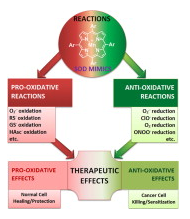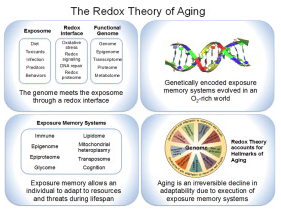Click here to view the complete article in Redox Biology
Most of the SOD mimics thus far developed belong to the classes of Mn-(MnPs) and Fe porphyrins(FePs), Mn(III) salens, Mn(II) cyclic polyamines and metal salts. Due to their remarkable stability we have predominantly explored Mn porphyrins, aiming initially at mimicking kinetics and thermodynamics of the catalysis of O2− dismutation by SOD enzymes. Several MnPs are of potency similar to SOD enzymes. The in vivo bioavailability and toxicity of MnPs have been addressed also.
 Numerous in vitro and in vivo studies indicate their impressive therapeutic efficacy. Increasing insight into complex cellular redox biology has been accompanied by increasing awareness of complex redox chemistry of MnPs. During O2− dismutation process, the most powerfulMn porphyrin-based SOD mimics reduce and oxidize O2− with close to identical rate constants. MnPs reduce and oxidize other reactive species also (none of them specific to MnPs), acting as reductants (antioxidant) and pro-oxidants.
Numerous in vitro and in vivo studies indicate their impressive therapeutic efficacy. Increasing insight into complex cellular redox biology has been accompanied by increasing awareness of complex redox chemistry of MnPs. During O2− dismutation process, the most powerfulMn porphyrin-based SOD mimics reduce and oxidize O2− with close to identical rate constants. MnPs reduce and oxidize other reactive species also (none of them specific to MnPs), acting as reductants (antioxidant) and pro-oxidants.
Distinction must be made between the type of reactions of MnPs and the favorable therapeutic effects we observe; the latter may be of either anti- or pro-oxidative nature. H2O2/MnP mediated oxidation of protein thiols and its impact on cellular transcription seems to dominate redox biology of MnPs. It has been thus far demonstrated that the ability of MnPs to catalyze O2−dismutation parallels all other reactivities (such as ONOO− reduction) and in turn their therapeutic efficacies.
Assuming that all diseases have in common the perturbation of cellular redox environment, developing SOD mimics still seems to be the appropriate strategy for the design of potent redox-active therapeutics.
— Published
Categories: Education, Redox Biology
By: Kelly K. Andringa, PhD, MBA, University of Alabama at Birmingham Division of Nephrology Program Manager
 As Michelle mentioned last month you don’t want to be nearing the finish with your postdoc (or perhaps even your graduate training) without having a career goal or target in mind. These goals and targets can change, but you should have some idea where you’d like to start. Sometimes these goals aren’t the same as your mentors and you might not have any idea exactly how to get where you want to go. This is where you need an active network (something else Michelle mentioned) to help you out.
As Michelle mentioned last month you don’t want to be nearing the finish with your postdoc (or perhaps even your graduate training) without having a career goal or target in mind. These goals and targets can change, but you should have some idea where you’d like to start. Sometimes these goals aren’t the same as your mentors and you might not have any idea exactly how to get where you want to go. This is where you need an active network (something else Michelle mentioned) to help you out.
Networking is discussed ALL the time as the vital part of any career path, not just science. If your career aspirations take you away from the traditional academic faculty track you will need to reach out and talk to others who have those roles you’re interested in. “Alternate careers” is a phrase that gets thrown around a lot. The statistics about obtaining an academic faculty position look daunting (see this video from Dr. Sally Rockey about the average age of faculty and R01 PIs in academia over the last 20+ years) and lead people to think about exploring other options. Now, let me be clear, I thoroughly enjoy my “alternate career,” it is in no way my “back up plan.” I haven’t taken the positions I have after my postdoc because I was discouraged from being faculty, I went into this career path fully aware of what I was getting into and what I was giving up. I definitely think that careers in academic research are possible and people who want them should absolutely go for them. I am not that person.
During my graduate training I had 5 projects going, I needed a bit of help narrowing my focus. About the time of my qualifying exams, my mentor and I had a good sit down about my career goals and aspirations. Although I had initially gone to graduate school with the goal of running my own lab and working on more tolerable therapeutics for cancer treatment, I had started to realize I had skill sets that would be better utilized outside the lab. Fortunately, my graduate and postdoctoral mentors were open to those discussions about careers outside of academic faculty positions. Thankfully, I’m reasonably willing to talk about the things I want/need regardless of the outcome, but not everyone has mentors that are supportive of other career paths. Luckily, Science Careers (sponsored by AAAS) has an online IDP (Individual Development Plan) to help you determine your interests and get them down ‘on paper’ so you have a career plan going forward that you can modify and discuss.
Clearly, there are a number of “alternate careers” out there and I’m hoping there will be more blog posts about some of the other ways people utilize their PhD’s outside of academia. I can only speak to my area of interest, I’m in Research Administration. What do I do every day?? Well my daily tasks are varied and no day is the same. I’m currently a Program Manager at the University of Alabama at Birmingham. I assist in the management of a multi-institution P30 grant that has three research areas with about 7 different core facilities involved with those areas. There is also a pilot grant program as well as educational components for seminars, workshops and training experiences. I also assist in the management of an NRSA postdoctoral training grant that currently funds 5 trainees, plus a number of other tasks for my boss and my division. Here is what I enjoy most about my job; I get to talk about all different kinds of science and research with so many different people. I help direct faculty interested in utilizing our core facilities to the correct people, I get to read about new and exciting research directions via the pilot studies proposed, and watch young scientists transition their careers where they want to go, it’s great. I do miss the bench work, but I think my skills are best utilized in helping others reach their scientific research goals.
So how did I get here? We have to take it back to networking, as Glinda told Dorothy; you’ve had the ability all along you just wouldn’t have believed me. In those original discussions with my graduate mentor, he mentioned that one of his classmates from graduate school was a program officer at NIH. He sent her an email asking if she would be willing to talk to me about her career and what her job entailed. Here’s a hint, informational interviews are a great way to connect with people who have jobs you’re interested in. This is not a time to pester them to get you a job or pass around your CV, this is informational, you are inquiring about their job, how they got there and what they do on a daily basis. I sent a number of emails and had friends send emails to people who had jobs I was interested in learning about. I talked to program officials at NIH, associate vice presidents of small and large universities, directors of sponsored programs, program managers from my university and others in compliance offices (IRB, IACUC etc.) about their jobs. Networking is important, don’t be pushy, and ask when a good time is to call. Have a number of questions ready but don’t plan to take up more than 30 minutes of their time (maybe less), they can make it go longer but you shouldn’t be the one keeping them on the phone for hours, they’re busy and you want them to remember you were sensitive to their time.
So you’re likely thinking, great advice Kelly, but does it really work? In fact yes, it does work. One of those informational interviews I had was with someone who also had transitioned from a postdoc to grants management. A year after I spoke with her, her division was looking for someone to manage and ARRA funded multi-site project. She contacted me to see if I was still interested in administration and if I would like to interview for the job. So see, making a good impression while learning about someone else’s job got me an “in” for an interview. Networking won’t necessarily get you the job. Your education, training, and knowledge will get you the job; networking can help get you in the door.
— Published
Category: Education
By: Michelle Booze, Postdoctoral Fellow, Children’s Health Research Center at Sanford Research - @DrMLBooze, @sanfordhealth
This past March I had the opportunity to attend the National Postdoctoral Association (NPA) 2015 Annual Meeting. What I learned there helped me to focus on my future as a scientist. Are you getting the career help you need to determine your future? Luckily, there is a wealth of information out there to help you along your journey. The following are 5 rules to get you started down the right path to your dream career.

Rule #1: Don’t be this person
This information was presented by Sarah Cardozo-Duncan (@sarahcarstrat) and James Gould (@HMSpostdoc) during a workshop at the meeting. It is important not to be the person who:
Rule #2: Know what you want to do with your degree
It is very important that you take time to think about where you want to be in your future. It’s never too late to figure this out and start pursuing your goal. Don’t set unrealistic goals, but don’t hold back either or you might not reach your full potential!
Rule #3: Find a valuable mentor
If you want your PI’s/Advisor’s/Boss’s job, then they are the right target for a mentor. If you want a different position, find another mentor. There are a ton of resource materials on nurturing a successful mentor relationship. Look to the societies you’re involved in, such as SFRBM, for help.
Rule #4: Make connections
An informational interview is all about getting to know someone and the place they work (and sharing a little bit about yourself too!). It’s not about flinging your CV at them (although you should have a copy ready to fling). There’s a nice entry about the Informational Interview here - http://thepostdocway.com/content/michelles-corner.
Rule #5: Know your Resources
There are a myriad of great web sources at our disposal to take advantage of.
Remember, your future is up to you. It is your responsibility to reach your own goals.
— Published
Category: Education
By: Dean P. Jones, Emory University
Click here to view the full article in the journal Redox Biology
 Metazoan genomes encode exposure memory systems to enhance survival and reproductive potential by providing mechanisms for an individual to adjust during lifespan to environmental resources and challenges. These systems are inherently redox networks, arising during evolution of complex systems with O2 as a major determinant of bioenergetics, metabolic and structural organization, defense, and reproduction. The network structure decreases flexibility from conception onward due to differentiation and cumulative responses to environment (exposome). The redox theory of aging is that aging is a decline in plasticity of genome–exposome interaction that occurs as a consequence of execution of differentiation and exposure memory systems. This includes compromised mitochondrial and bioenergetic flexibility, impaired food utilization and metabolic homeostasis, decreased barrier and defense capabilities and loss of reproductive fidelity and fecundity. This theory accounts for hallmarks of aging, including failure to maintain oxidative or xenobiotic defenses, mitochondrial integrity, proteostasis, barrier structures, DNA repair, telomeres, immune function, metabolic regulation and regenerative capacity.
Metazoan genomes encode exposure memory systems to enhance survival and reproductive potential by providing mechanisms for an individual to adjust during lifespan to environmental resources and challenges. These systems are inherently redox networks, arising during evolution of complex systems with O2 as a major determinant of bioenergetics, metabolic and structural organization, defense, and reproduction. The network structure decreases flexibility from conception onward due to differentiation and cumulative responses to environment (exposome). The redox theory of aging is that aging is a decline in plasticity of genome–exposome interaction that occurs as a consequence of execution of differentiation and exposure memory systems. This includes compromised mitochondrial and bioenergetic flexibility, impaired food utilization and metabolic homeostasis, decreased barrier and defense capabilities and loss of reproductive fidelity and fecundity. This theory accounts for hallmarks of aging, including failure to maintain oxidative or xenobiotic defenses, mitochondrial integrity, proteostasis, barrier structures, DNA repair, telomeres, immune function, metabolic regulation and regenerative capacity.
— Published
Categories: Education, Redox Biology
 By: Dr. Jack Lancaster (http://www.doctorno.org)
By: Dr. Jack Lancaster (http://www.doctorno.org)
For those of you who are graduate students or postdocs, it might seem like you’ve been in school forever! However, consider the three major segments of the entire time span of a career as an independent investigator:
Check out the time differences of training compared to independence: ≈ 8-fold. So as a foundation for your future, what do you want to develop during this initial critical 12% training time?
As much as you can, eschew specialization. In spite of what your institution may have embedded in its training program, the best and most rewarding path is to, as the Biochemist and writer Isaac Asomov advocated, cultivate “A View from a Height”.
Don’t sell yourself short!
So during this critical 12% training period, challenge yourself in the most rigorous pursuits in Mathematics, Physics, and Chemistry you can find because this will equip you with the tools to truly understand phenomena on the most defining (molecular) level.
Then, throughout your long career you can apply to any Biological query all these wonderful universal physical concepts that must apply to all of Biology. And the more fundamental and interdisciplinary your skillset, the more puzzles you will be attracted to to solve, and the more significant they will be. And that’s a pretty good description for the successful career of a lifelong “lover of knowledge” (i.e., PhD).
— Published
Category: Education